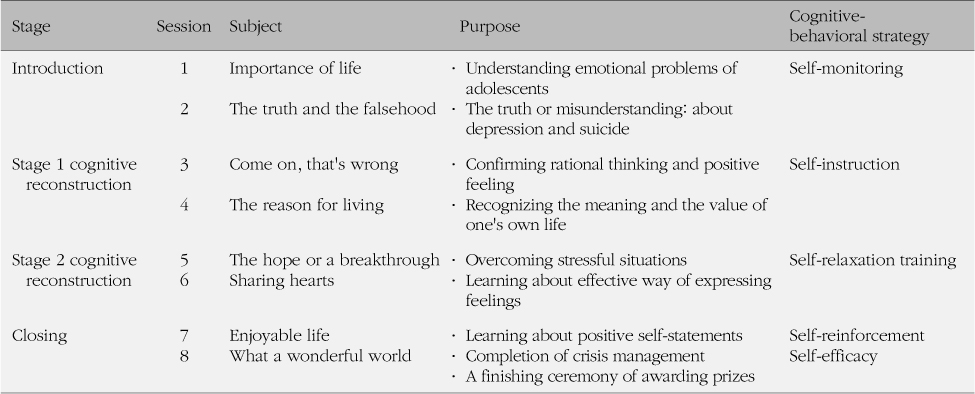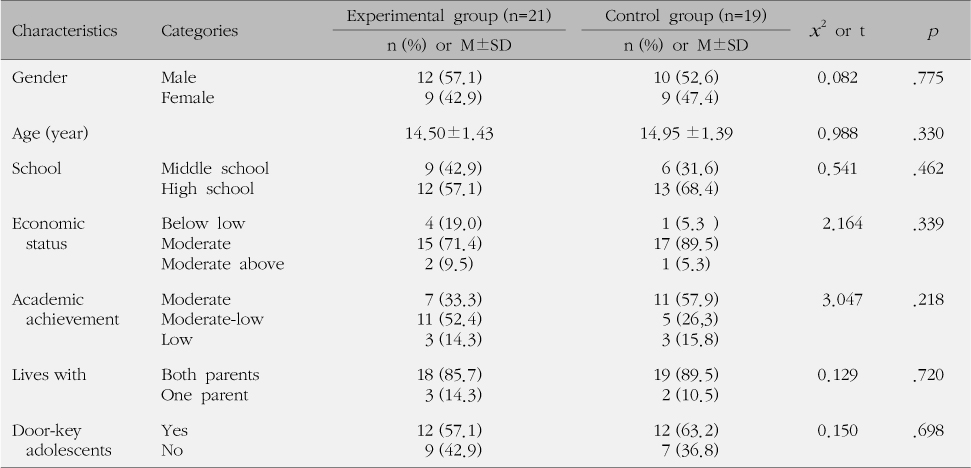Articles
- Page Path
- HOME > J Korean Acad Community Health Nurs > Volume 21(1); 2010 > Article
-
Original Article
- The Effects of a Depression Intervention and Suicide Prevention Program in Adolescents with High Risk of Suicide
- Jae Soon Yoo, Jung Woo Son, Min Sun Nam
-
Journal of Korean Academy of Community Health Nursing 2014;21(1):71-81.
DOI: https://doi.org/10.12799/jkachn.2010.21.1.71
Published online: April 4, 2014
1Professor, Department of Nursing, Chungju National University, Korea.
2Associate Professor, Department of Neuropsychiatry, College of Medicine, Chungbuk National University, Korea.
3Psychiatric Mental Health Nurse, Cheongwon-gun Mental Health Center, Korea.
• Received: January 13, 2010 • Revised: March 5, 2010 • Accepted: March 10, 2010
© 2010 Korean Academy of Community Health Nursing
This is an Open Access article distributed under the terms of the Creative Commons Attribution Non-Commercial License (http://creativecommons.org/licenses/by-nc/3.0/) which permits unrestricted non-commercial use, distribution, and reproduction in any medium, provided the original work is properly cited.
- 593 Views
- 2 Download
- 5 Crossref
Abstract
-
Purpose
- This study was to examine the effects of a depression intervention and suicide prevention program in adolescents with high risk of suicide.
-
Methods
- This research was designed as a nonequivalent control group pretest-posttest study. The participants were adolescents with high risk of suicide in mental health screening examination. A total of 40 adolescents (experimental group=21, control group=19) were sampled from C-gun, Chungbuk Province. The experimental group participated in the depression intervention and suicide prevention program for eight sessions while the control group did not participate in the program. Data were collected with a self-reporting structured questionnaire from November to December, 2008. SPSS/Win 12.0 was used for data analyses including chi-square test, t-test, and paired t-test.
-
Results
- After this program, there was no statistically significant difference in depression (t=1.498, p=.142) between the two groups, but depression decreased in the experimental group. There was a statistically significant difference in suicide ideation (t=2.058, p=.047).
-
Conclusion
- To decrease depression and suicide ideation in adolescents with high risk of suicide, it is necessary to offer this program in a more intensive course and for a longer period. Also, family consultation programs and individual case treatment and consultation programs should be offered.
-
The research was supported by a grant from Chungju National University Research Foundation in 2008.
NOTES
- 1. Chung HK, Ahn OH, Kim KH. Predicting factors on youth suicide impulse. Korean J Youth Stud. 2003;10(2):107–126.
- 2. Cho CC, Lee YS. Development of the Korean form of the Kovacs' childrens' depression inventory. J Korean Neuropsychiatr Assoc. 1990;29(4):943–956.
- 3. Hyun M, Kim MA. The effects of the cognitive-behavioral therapy on depression and self efficacy of the problem behavior adolescents in middle school. J Korean Acad Psychiatr Ment Health Nurs. 2004;13(4):458–466.
- 4. Jang HJ. The relationship between stress, depression, & suicidal ideation among high school students in a city. Seoul: Ewha Womans University; 2004. Unpublished master's thesis.
- 5. Kim HS. The present state of suicidal act of the young people and confrontation a plan-centering around a middle schoolboy. Daegu: Keimyung University; 2003. Unpublished master's thesis.
- 6. Kim JY. The effects of suicide prevention program among adolescents in school. Suwon: Ajou University; 2004. Unpublished master's thesis.
- 7. Kim YA, Kwon YS, Park KM. The relationship among the suicidal risk, self-esteem, spiritual well-being of high school students. J Korean Acad Community Health Nurs. 2006;17(1):112–124.
- 8. Kim YS. The effects of a group counseling program on depression and suicidal prevention in high school students. J Korean Acad Community Health Nurs. 2009;20(3):343–350.
- 9. Korea Centers for Disease Control and Prevention. The 2007 online survey of the health behavior among adolescents 2008;Retrieved November 20, 2008. from http://cdc.go.kr/kcdchome/jsp/general/search/tot/
- 10. Korea Centers for Disease Control and Prevention. The 2008 online survey of the health behavior among adolescents 2009;Retrieved February 24, 2009. from http://cdc.go.kr/kcdchome/jsp/home/brd/
- 11. La HJ. Factors influencing the impluse of suicide in adolescence. Seoul: Konkuk University; 2005. Unpublished master's thesis.
- 12. Lee CS, Kweon YR, Kim SJ, Choi BS. The effects of suicide prevention program on depression, suicidal ideation, and problem solving ability on middle school students. J Korean Acad Psychiatr Ment Health Nurs. 2007;16(4):337–347.
- 13. Lee EO, Lim NY, Park HA. Nursing · medical research and statistical analysis. Seoul: Soomoonsa; 1998.
- 14. Lee ES. Construction of a structural model about male and female adolescents' alienation, depression, and suicidal thoughts. J Korean Acad Nurs. 2007;37(4):576–585. ArticlePDF
- 15. Lee JS. The relationship between individual and family variation and depression of adolescents. Seoul: Chungang University; 2006. Unpublished master's thesis.
- 16. Lee YS. Effects of the Satir's family reconstruction group counseling based on mediation model between family support and depression and anxiety. Chonju: Chonbuk National University; 2004. Unpublished doctoral dissertation.
- 17. Lee YS, Suh DS, Yang SH, Lee KH. Development of Korea adolescent form of suicidal ideation questionnaire. J Child Adolesc Psychiatry. 2004;15(2):168–177.
- 18. Ministry of Education, Science and Technology. Systematic health education curriculum for the modified portion notic 2008;09 11 Retrieved November 20, 2008. from http://mest.korea.kr/gonews
- 19. Ministry for Health, Welfare and Family Affairs. Health plan 2010 2005;Retrieved August 2, 2009. from http://2010.hp.go.kr/goal/
- 20. Ministry for Health, Welfare and Family Affairs. Child and adolescents mental health service 2008a;Retrieved September 3, 2008. from http://www.mw.go.kr/front/jb/sjb03030/vw.jsp
- 21. Ministry for Health, Welfare and Family Affairs. The 2nd strategy for suicide prevention 2008b;Retrieved September 3, 2009. from http://www.mw.go.kr/front/jb/sjb03030/vwo.jsp
- 22. OECD. Society at a glance-OECD social indicators 2009;Retrieved August 2, 2009. from http://www.oecd.org/els/social/indicators/SAG
- 23. Oh HA. The effects of parent-adolescent communication on the suicide ideation. Seoul: Chungang University; 2006. Unpublished master's thesis.
- 24. Seo HS. A study of factors influencing on adolescent's suicide thinking. Daegu: Daegu University; 2006. Unpublished doctoral dissertation.
- 25. Shim MJ. The effects of life-respect education program on the respect for life and attitudes toward suicide of middle school students with difficulties adjusting to school life. Seoul: Ewha Womans University; 2007. Unpublished master's thesis.
- 26. Statistics Korea. 2008 Annual report on the cause of death statistics. Daejeon: Statistics Korea; 2009.
- 27. The Central Mental Health Supporting Committee. Child and adolescents case management program 2008;Retrieved August 3, 2008. from http://www.cmhsc.or.kr
- 28. Yoo JS, Son JW, Nam MS. Factors influencing suicide ideation among adolescents. J Korean Acad Community Health Nurs. 2008;19(3):419–430.
- 29. WHO. Preventing Suicide: A Resource for the teachers and other staff 2000;Retrieved August 2, 2009. from http://www.who.int/mental_health/prevention/suicide/suicideprevent/en
- 30. Wichstøm L. Predictors of adolescents suicide attempts: A nationally representative longitudinal study of Norweigan adolescents. J Am Acad Child Adolesc Psychiatry. 2000;39(5):603–610.
Figure & Data
References
Citations
Citations to this article as recorded by 

- Predicting South Korea adolescents vulnerable to depressive disorder using Bayesian nomogram: A community-based cross-sectional study
Haewon Byeon
World Journal of Psychiatry.2022; 12(7): 915. CrossRef - Association between academic performance and depression, suicidal behavior among Korean adolescents
Ji Eun Kim, Sun Jung Kim
Korean Journal of Health Education and Promotion.2020; 37(3): 57. CrossRef - Determinants of Mental Health Care Utilization in a Suicide High-risk Group With Suicidal Ideation
Hyun-Soo Kim, Moo-Sik Lee, Jee-Young Hong
Journal of Preventive Medicine and Public Health.2016; 49(1): 69. CrossRef - A review of school-based suicide prevention interventions in South Korea, 1995–2015
Jung Won Kong, Jung Woo Kim
Children and Youth Services Review.2016; 69: 193. CrossRef - Validation of the Mood and Anxiety Symptom Questionnaire in Korean Adolescents
Seul-Ah Lee, Keun-Hyang Kim, Sun-Mi Cho
Psychiatry Investigation.2015; 12(2): 218. CrossRef

 KACHN
KACHN




 PubReader
PubReader Cite
Cite

